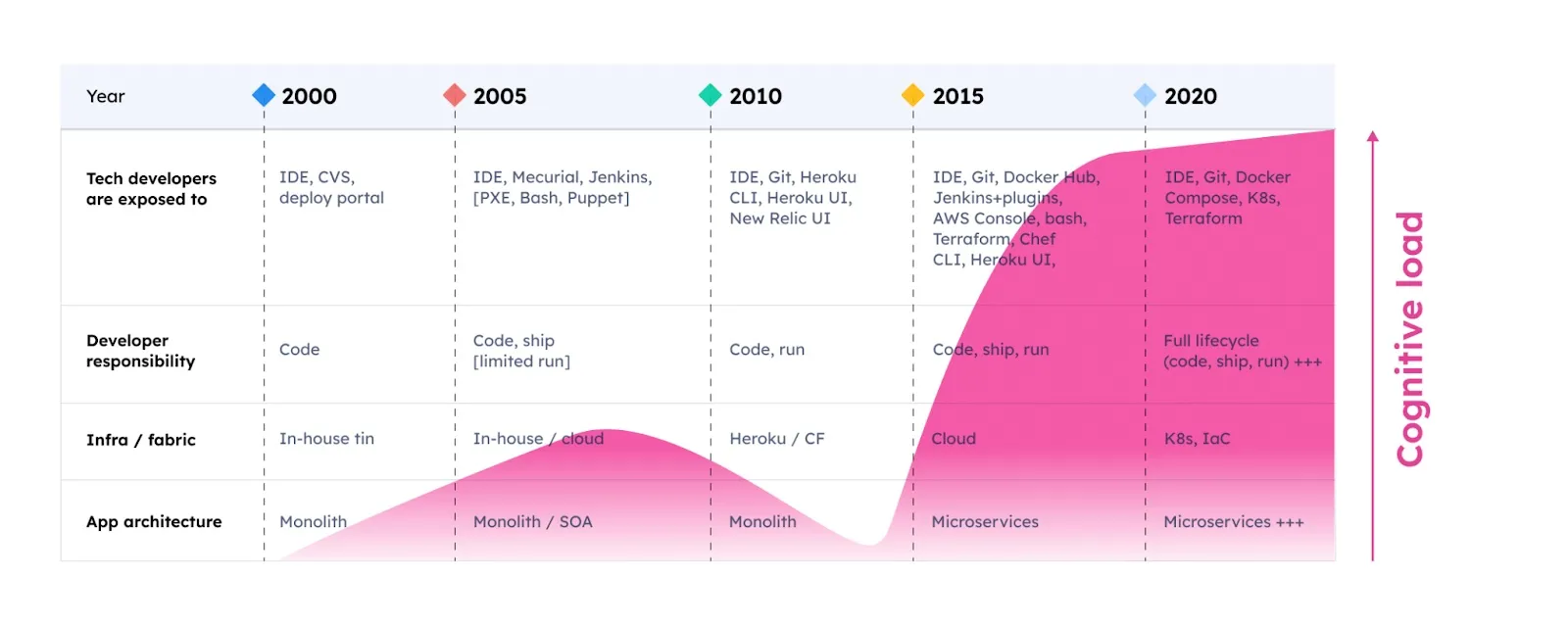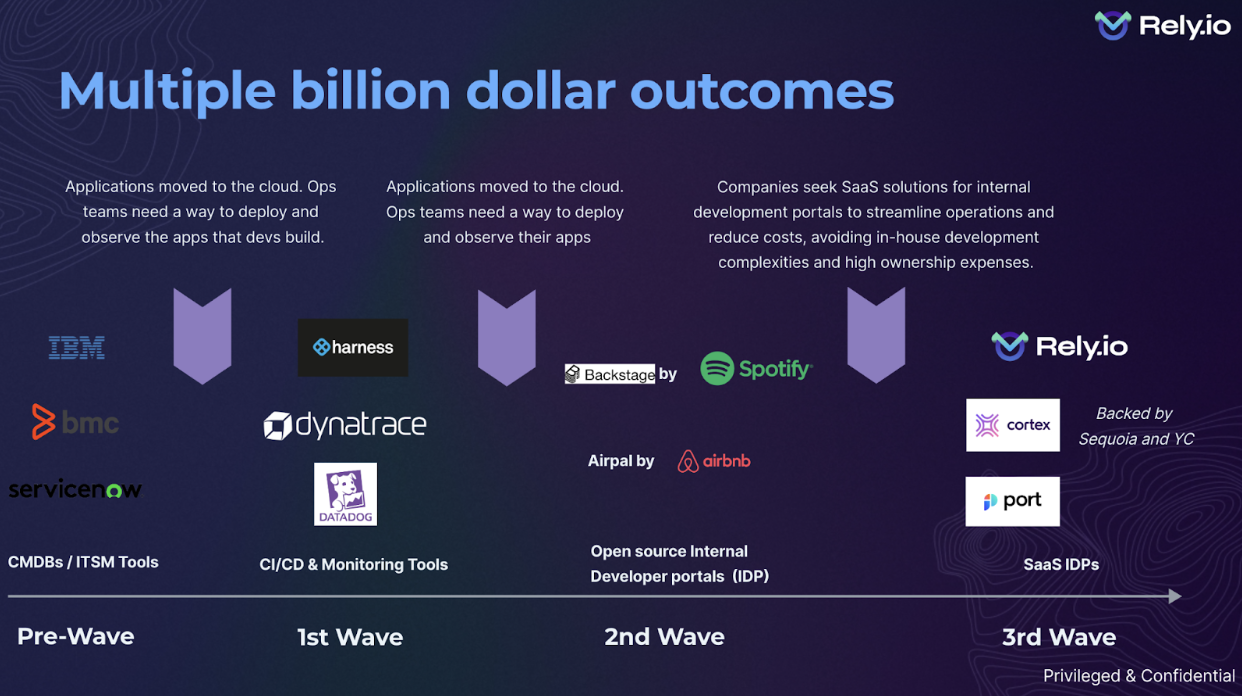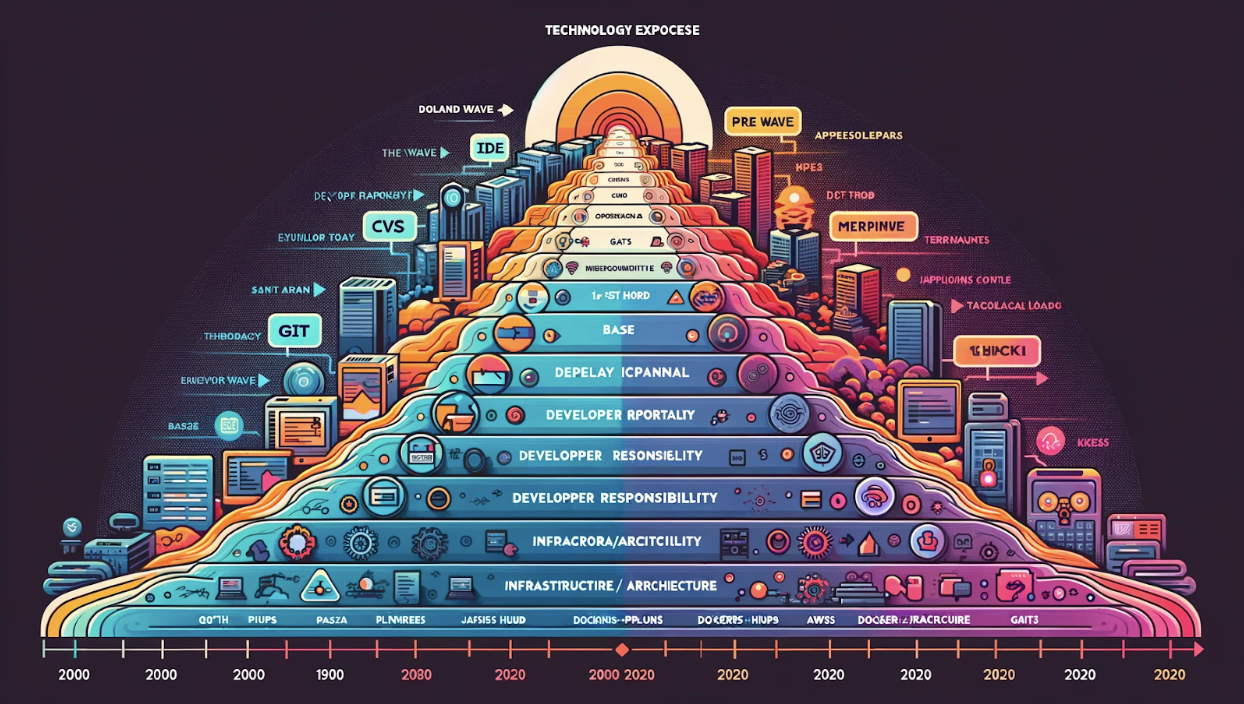Building a Commercial Playbook
A thesis on how platform engineering has become an evermore complex task, increasingly demanding solutions to manage all processes and tools. Empowered by LLM capabilities, Internal Developer Portals have an important role in the upcoming decade and will become an indispensable tool for any engineering team, creating a new multi-billion, or even trillion dollar industry.
Why now? From Code to Complexity

The infographic snapshots a two-decade sprint in the tech development realm, where the starting line in 2000 was a simpler time with IDEs, CVS, and deploy portals. Developers' minds were laser-focused—write the code and pass it on.
Fast forward to 2005, the landscape's complexity crept up with Jenkins and Bash. The cloud was a mere wisp on the horizon, and developers dipped their toes into the operations pool, but monoliths still ruled the architecture block.
The 2010 mark brought Git and Heroku into the mix, putting more on the developer's plate—code it, ship it, run it. The cloud grew from a puff to a presence, but the monolith stood its ground, unchallenged.
By 2015, Docker and AWS threw their hats in the ring. Tools proliferated like rabbits, and microservices began to edge out the monolithic monuments of yore. Now, developers weren't just coding—they were shipping, running, and on-call 24/7.
By 2020? The toolkit exploded—Serverless, Docker Compose, K8s, Terraform—and the full lifecycle of an app was now in the developers' hands. 'Cognitive load' wasn't just a buzzword; it was the bane of the dev life. Infrastructure turned to K8s, and apps were now a complex web of microservices.
Today, engineering teams suffer from lack of discoverability, inconsistent UI, repetitive Toil.
1) Discoverability
The vast sea of critical data is often dispersed across a myriad of locations, tools, and hyperlinks, presenting a time-consuming challenge in locating what is needed. So even if one remembers the services (which is often a problem too) - knowing how and where to access them remains a challenge to be solved.
2) Inconsistent UI
The patchwork of internal tools, each with its unique interface and quirks, demands developers become jack-of-all-trades, mastering countless systems. A uniform UI is essential to eliminate the steep learning curve associated with juggling these disparate environments.
3) Demotivating work
The large number of infrastructure tools create a tide of monotonous tasks—setup, configuration, maintenance—siphoning precious time and stifling creativity. This routine toil, resistant to automation, bogs down development and is costly not only in terms of developer hours, but maybe worse, in terms of motivation and ability to focus on what creates business value.
Enough is enough: Enter the Internal Developer Portal (IDP) — the Digital Command Center for Engineering Teams
As tools and tasks multiplied, the developer's brain-space became prime real estate. Enter internal developer portals, the tech world's answer to simplifying the chaos. They consolidate the sprawl into a one-stop digital command center with a single unified experience - solving 1) Discoverability, 2) Inconsistent UI and 3) Demotivating Work —tools, docs, support, you name it—trimming the cognitive clutter and letting devs get back to what they do best: building the future, one line of code at a time.
The Trillion Dollar Industry: Orchestrating Platform Services and Developer Portals
Over the last two decades giants like ServiceNow (founded 2004, today ~$160b market cap) have been addressing the service management of how to run an IT environment - started during an era of static Virtual Machines and Data Centers, before the dominance of cloud computing, naturally the challenges are different and make the giant a clear legacy provider.

Historically the market of IT orchestration, platform services, and now developer portals has evolved in three waves according to Rely.io’s founder José Velez:
Pre-Wave: Designing Foundations for Cloud Transition
In the initial sketches, giants like IBM, BMC, and ServiceNow laid the groundwork. Their tools for Configuration Management Databases (CMDBs) and IT Service Management (ITSM) provided the scaffolding for applications shifting to the cloud, enabling ops teams to deploy and monitor the digital structures developers crafted with precision.
1st Wave: Erecting Robust CI/CD and Monitoring Frameworks
Harness and Dynatrace, reinforced by Datadog, started to construct robust frameworks for Continuous Integration/Continuous Deployment (CI/CD) and monitoring. This phase marked an era where developers could erect and supervise their applications in the cloud with improved efficiency and oversight, ensuring seamless deployment cycles.
2nd Wave: Drafting Open Source Developer Portals
Then, open source innovators like Spotify with Backstage and Airbnb with Airpal, shared their blueprints for internal developer portals. These platforms have been like open source templates that any enterprise could customize for their own development landscape, aiming to cut costs, bypass the complexity of in-house development, and reduce the fiscal footprint of proprietary systems.
3rd Wave: Streamlining with SaaS IDPs
In the more recent wave, companies like Cortex, Port, and Rely have started to streamline the build process with SaaS Internal Developer Portals (IDPs), offering a ready-to-use solution for development teams. These portals simplify the management maze, providing a unified experience where developers can efficiently craft and control their applications, allowing them to concentrate on innovating and coding without getting lost in the information and tool proliferation nightmare.
*If you want to learn more about IDPs I suggest reading this article by Rely.io
IDPs for the AI era — A powerful LLM Enabled Development Ally.
First, I asked ChatGPT to visually draw me the future. It’s crystal clear; you gotta love the predictive nature of LLMs.

More seriously. In the future developer portals will act as the go-to interface between developers (and perhaps even non technical people) and their software ecosystems. Allowing people to simply write or speak what they want to to achieve.
Since the developer portal typically integrates with all the interfaces of the engineering tools, when empowered with AI, people will be able to ask any question or ask it to do any action and it will convert the request into the appropriate answer or action.
Most interestingly, it would be fair to assume that no other product would be able to do so, nor AI on its own due to the unstructured nature of all this data across services and data sources.
Hence, over time the key function of IDPs will be to structure all widely spread information into a single data model, becoming a powerful development ally to every developer focused on building the future, one line of code at a time.
Part 7/10
A Sales Methodology is a framework or set of guiding principles that walks a sales team through a staged, repeatable process to win clients and close revenue. It is a philosophy of how you want to sell, a part of your overall sales identity and DNA, and it sets the tone for approaching each and every lead and opportunity. Sales Methodologies (often also referred to as Sales Qualification tools) provide a blueprint for the ruthless qualification of leads and opportunities, and a handrail process to optimise the likelihood of closing a deal. They define the sales language you use, how you run discovery and qualification processes, and ultimately set the stool out for how you sell within your company
There exists a huge amount of written content, manuals, guides and commentary on sales methodologies, creating what is often a minefield for founders as they think about setting up and scaling a sales organisation. There is no one size fits all when it comes to choosing and adopting a sales methodology, and what works depends on a number of factors not least:
- who you sell to (ICP).
- fit and complexity with your product or service.
- the value of what you sell.
- how large your sales team is (and who is leading it — people have their “favourites” when it comes to sales methodologies and tend to stick with them religiously, rightly or (sometimes) wrongly!).
- what systems you have to support your sales process (e.g. CRM).
- what type of revenue model you expect to have (e.g. non-recurring, recurring, repeat…).
- how you will need a methodology to bend and evolve as the company grows and scales.

What is key is landing on a framework that is right for the business model and capability of your team. Do not overcomplicate things by implementing a sales methodology that is overkill for the simplicity of what you sell and how you sell. Equally, if you are selling a product or service that is complex, non-standard or bespoke in nature per customer, or your ICP is predominantly enterprise level customers, a well-structured framework will almost certainly add value and pay dividends in getting to a sales-market-fit (SMF) faster, and in a more repeatable and scalable way.
Don’t underestimate how impactful following a sales methodology and ruthless qualification process can be to elevate accuracy, efficiency and velocity. Without a defined process and way of selling, how can you expect to evaluate effectiveness, benchmark against good/best practice, and successfully onboard sales hires and bring them into anything remotely structured.
Choosing an Option
Here are some of the most commonly used Sales Methodologies in practice. Almost all owe a degree of debt (in my humble opinion) to the forefathers of sales methodologies aka the Sandler Selling System, and the Miller Heiman Solution Selling. These were sales methodologies born out of the 60s and 70s, with many citing sales leaders at Xerox as the originators of what we now recognise a lot of, across all methodologies used in modern selling.
All of the following frameworks are relevant for software and technology businesses, and arguably both recurring and non-recurring revenue models. What one would consider the modern methodologies such as GPCT and SPICED have evolved out of the traditional methods used consistently over the past 30–40 years.
- SPIN
- BANT
- GPCT
- MEDDIC
- Scotsman
- SPICED
- Challenger Sales
Going Forward
Choosing a sales methodology is as much a philosophical decision as it is a practical one. Those that have worked with certain methodologies generally carry them throughout their careers and reapply them over and over, or evolve their application based upon modern techniques, tools and the ever evolving buyer profile. Regardless of which one you decide is right for you and your company, the starting point is to align any sales methodology with your business goals. If a sales philosophy is not supporting you in achieving your goals, it is not serving its purpose.
Also ensure you remain open minded and agile in your methodology and application. The sales environment is evolving quickly, disrupted by digital technologies, AI and a more (generally) educated and well researched buyer. Do not be too stubborn to think your sales methodology and approach is immune to macro-level changes. Continue to follow the trends, educate yourself on modernised methods and techniques. Evaluate how (and which parts of) these can be adapted and utilised to enhance your go-to-market, and how you sell. Also make sure you are adopting a methodology that is specifically suitable for your ICP, Personas and sector dynamics.
Importantly, also take the time for internal sales enablement and training. Assess and evaluate the team on capabilities and skills, and choose a methodology through the lens of the maturity of the team and how easy it will be to integrate into their daily activities and existing tool kit.
Finally, ensure that whatever sales methodology you pick, you define and implement simple and measurable KPIs to evaluate its effectiveness, its application by the team, and the results and outcomes it is driving. Commit to it and own it!
Further Reading: SPIN Selling by HighSpot, How to use BANT to Qualify Prospects by Hubspot, GPCT vs. BANT: Why GPCT is More Effective by Weflow, MEDDIIC, The SCOTSMAN Methodology: Enhance Your Higher-ticket Deals by Amy Copadis, What is missing from MEDDIC, A brief history of modern sales methodologies for sales leaders by George Brontén
Access the google slide templates here:
The J12 Commercial Excellence Playbook — All Template Slides (2022).







